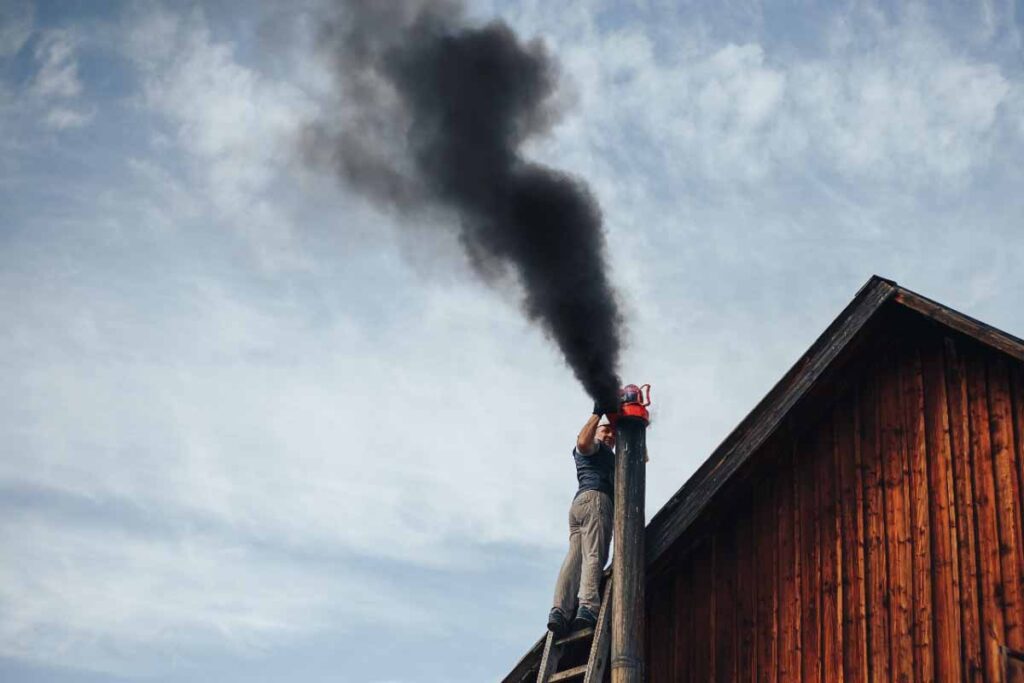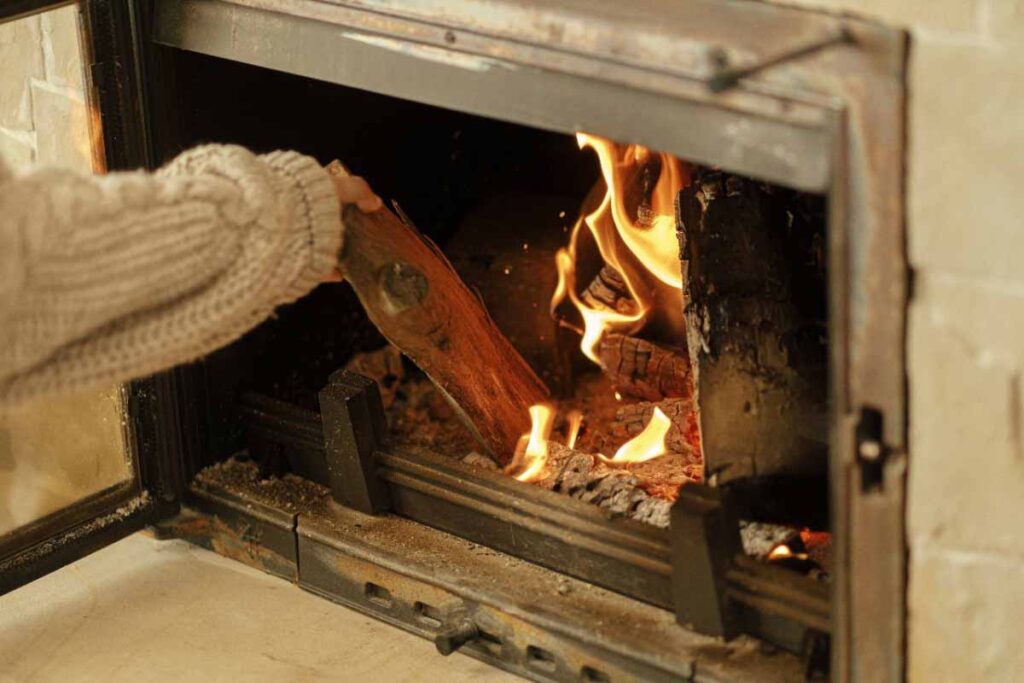The safety and efficiency of your home depend on your chimney being clean and functional. Many individuals utilize chimney cleaning logs, sometimes referred to as fireplace log cleaners. But are these logs as promised actually effective? This page will explore the reality that do chimney cleaning logs work and maintain good shape of your chimney and their effectiveness. We will strive to offer the whole response to this often-asked question: do chimney cleaning logs work up to their claims? Our information will help you determine the best approach to maintain the efficiency and safety of your chimney in your house.
Understanding Chimney Cleaning Logs and Their Purpose
Keeping your fireplace or wood stove running effectively can be accomplished with chimney cleaning logs, sometimes referred to as fireplace log cleaners or chimney sweep logs. Over time, they help eliminate creosote and other dangerous deposits accumulating in the chimney.
How Chemical Catalysts Work in Cleaning Logs
These logs’ success comes from their unique compounds. These compounds split down other wastes including creosote into tiny pieces. This facilitates easier chimney cleaning during routine sweeps.

Types of Deposits These Logs Target
- Creosote: A very flammable material that may build up on the chimney’s inside walls and seriously increase fire risk.
- Soot: A by-product of incomplete combustion, soot can also help the wood stove or fireplace’s efficiency to be lowered and help to form deposits.
- Tar and other flammable materials: Their ability to stick to the chimney walls helps to further restrict airflow and raise the chimney fire danger.
Regular use of chimney cleaning logs helps to maintain your chimney in safe and clean state. It lessens the need for regular expert sweeps and the chance of chimney fires.
Do Chimney Cleaning Logs Work: Effectiveness and Limitations
Many homeowners clean their fireplaces with chimney cleaning logs. These logs seek to increase fireplace efficiency and clear creosote accumulation. Still, it’s crucial to understand their limits and performance.
Chemicals in chimney cleaning logs help to break down creosote, a wood burning byproduct. They are supposed to minimize fire hazards and clean the chimney. Still, their success depends on the conditions of your chimney and the creosote accumulation.
On thick, hard creosote these logs might not be very effective. Under such circumstances, one needs a professional sweep. The type of wood, fireplace efficiency, and frequency of using of the logs also determine their success.
| Chimney Cleaning Method | Effectiveness on Thick Creosote Buildup | Cost |
| Chimney Cleaning Logs | Moderate | Low |
| Professional Chimney Sweep | High | Moderate to High |
A cheap and simple approach to keep your fireplace clean is with chimney cleaning logs. They do have limitations, though. See a professional routinely to get your chimney checked and cleaned if you want best results. This is particularly true should you notice a lot of creosote or question the potency of your wood.
How Do Chimney Cleaning Logs Work?
Popular for maintaining chimneys clean and effective are echo-friendly chimney cleaners including log chimney sweepers. Still, what drives them? Let’s investigate the science behind these items, including their chemical composition, how they breakdown creosote, and their long-lasting impacts.
Chemical Composition and Active Ingredients
Mixing natural chemicals and chemical catalysts, chimney sweep logs Ammonium salts form the major component. These breakdown the potentially hazardous wood-burning byproduct creosote. To further clean your chimney, the logs also include surfactants and organic acids.
How They Break Down Creosote
- The ammonium ions in the logs react with the creosote deposits to increase their solubility and ease of removal.
- The surfactants help the creosote to be emulsified and suspended, therefore facilitating sweep-away of it.
- The organic acids break down the creosote more easily so that chimney sweeps may safely remove it.
Duration of Treatment Effects
Logs for chimney sweepers don’t work one-time. They provide months of continuous protection. Frequent use of them maintains your chimney free. This helps your house heating be more environmentally friendly and lessens the demand for regular expert cleanings.
Comparing Cleaning Logs to Professional Chimney Sweeping
Many times, homeowners have to decide between professional chimney cleaning and log cleaning. Everybody has advantages and disadvantages. Understanding the variations lets you choose how best to maintain a clean chimney.
For basic upkeep, chimney cleaning logs are cheap and convenient. These include compounds that break down the combustible wood byproduct creosote. Burning these logs will help to avoid creosote accumulation. Still, they cannot equal a thorough, professional cleaning.
Deeper clean comes from professional chimney sweeping. Expert sweeps clean the complete chimney system using specific gear. They examine for issues with structure and safety as they clear any deposits. This guarantees both safety and good performance from your chimney..

| Chimney Cleaning Logs | Professional Chimney Sweeping |
| Convenient and cost-effective for basic maintenance | Provides a more thorough and comprehensive cleaning |
| Help break down creosote buildup | Identifies and addresses structural or safety issues |
| Not a replacement for professional cleaning | Ensures your chimney is operating efficiently and safely |
The necessity of your house will determine which of logs or professional sweeping is more appropriate. For routine maintenance and small accumulation, logs are handy. But a thorough clean and inspection call for a professional sweep. This guarantees for your house safe chimney cleaning and maintenance.
Best Practices for Using Chimney Cleaning Logs
Keeping your fireplace safe and effective is much enhanced by chimney cleaning logs. Still, you must use them appropriately if you want to maximize them. This implies employing the correct procedures as often as necessary, following them, and keeping safety while doing it. Let us consider the best approaches of using these logs.
Chimney Cleaning Methods
Closely follow manufacturer guidelines to maximize cleaning power from chimney cleaning logs. Usually, this entails exactly positioning the log on the fire. The chemicals in the log then help your chimney to break down creosote. Ensuring the correct location of the log enables the chemicals to reach every section of the chimney.
Frequency of Use Guidelines
- As you heat your house, once a month use a chimney cleaning log for routine maintenance.
- Should you notice a lot of clogs or creosote, you could find yourself using the log every two weeks.
- The wood you burn, how you burn it, and the state of your fireplace and chimney will all affect how often you use it.
Safety Precautions
- Using chimney cleaning logs will cause fumes, hence make sure you have excellent airflow.
- The log may be rough, hence avoid touching it with just your bare hands. Rather use gloves resistant to heat.
- Prepare a fire extinguisher just in case of any unplanned sparks or flames when cleaning.
- Discard the used log as advised by the manufacturer to prevent damage to the surroundings.
Using fireplace log cleansers effectively depends on following top standards. This maintains the safety and functionality of your chimney all season. Remember, enjoying your fireplace and the safety of your house depend on a clean chimney.
| Product | Application Method | Frequency of Use | Safety Precautions |
| Chimney Sweep Logs | Place directly on burning fire | Monthly during heating season, more often for heavy buildup | Ensure ventilation, use gloves, keep fire extinguisher nearby, dispose of properly |
Common Misconceptions About Fireplace Log Cleaners
Fireplace log cleaners are used by many homeowners to maintain chimneys free from debris and effective operation. However, there are rumors regarding some chimney cleaning solutions that can mislead individuals. Let us dispel some of these misconceptions and clarify the operation of these logs.
Others believe skilled chimney sweeps might be replaced with fireplace log cleaners. They are not a complete replacement even if they assist with creosote development. Certified sweeps can locate and fix problems that are not possible with logs.
Some say natural chimney cleaning logs are superior and safer than chemical ones. However, the components of a log determine its efficiency not only on its natural chimney cleaning but also on other aspects. Depending on the demand of your chimney, both kinds can perform effectively if used correctly.
- Professionally sweeping chimneys cannot be replaced by fireplace log cleaners.
- The “natural” label does not always imply that a chimney cleaning log is safer or more effective than products with chemical basis.
- With any kind of log cleaner, the intended cleaning outcomes depend on proper application frequency of usage.
Understanding these false ideas enables house owners to choose their chimneys properly. They might choose to have a professional sweep or use log cleaners.

Frequently Asked Questions
What are chimney cleaning logs and how do they work?
Cleaning the chimney One easy ecological approach to maintaining a clean chimney is with logs. Special chemicals they have break down creosote. Burning wood generates a hazardous material called creosote.
Are chimney cleaning logs effective in removing creosote buildup?
Indeed, log for chimney cleaning can help to lower creosote accumulation. Still, their performance relies on a few factors. These cover the degree of the accumulation as well as your use pattern. Not replacing expert cleanings, they are excellent for preventing accumulation.
How often should I use chimney cleaning logs?
Your frequency of using chimney cleaning logs will rely on several factors. These cover the kind of wood you burn and the frequency of using your fireplace. Using them at the beginning and end of the heating season makes sense. Or, do as the manufacturer advises.
Are chimney cleaning logs safe to use?
Correct usage of chimney cleaning logs guarantees their safety. Always check your air flow and don safety gear. Use them on a dirty chimney or mix them with other cleansers not advised.
Can I use chimney cleaning logs instead of hiring a professional chimney sweep?
Though they’re not a complete alternative for a professional sweep, chimney cleaning logs are a valuable tool for maintenance. Regular inspections and cleanings from a skilled professional are vital. This guarantees the appropriate and safe operation of your chimney.
What are the main advantages of using chimney cleaning logs?
The main advantages of chimney cleaning logs are their simplicity of usage, green effects, and capacity to maintain a chimney clean between sweeps. They might also save your money.
Are there any limitations or drawbacks to using chimney cleaning logs?
Though handy, chimney cleaning logs have certain drawbacks. Particularly if it’s accumulated a lot, they might not eliminate all creosote. Their efficiency may also decline if you neglect them or if your chimney is poorly maintained.
Conclusion
Do chimney cleaning logs work? The response is, quite honestly, somewhat. They can help to maintain your chimney in order. They do, however, have limitations. On some creosote varieties, they perform nicely; but, they cannot replace expert sweeps.
Safety and efficiency depend on your chimney’s remaining in good repair. One wise action is to use logs in conjunction with frequent sweeps. It lessens harmful creosote accumulation. Always refer to the safety guidelines and advice of the log manufacturer. Remember, logs may not address all forms of creosote or major problems like damage or obstructions.


